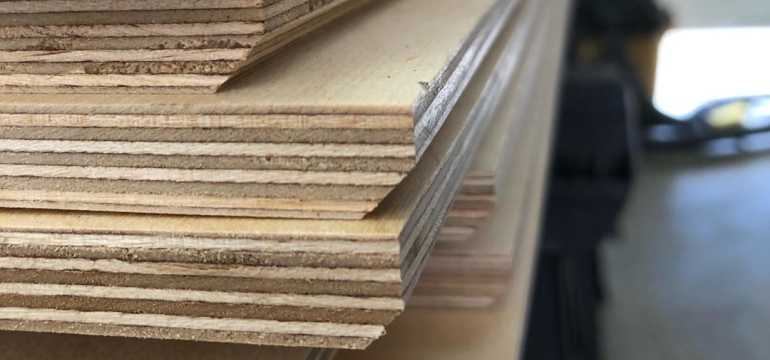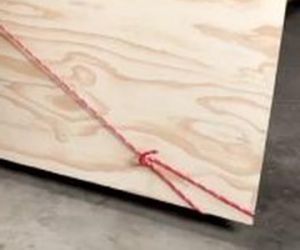Are you getting excited to get to work on your latest woodworking project? If you are in the planning stages and are about to go purchase your materials, there are a few things that you should know first. One of the biggest questions you need to ask yourself is whether you can handle purchasing and carrying your lumber on your own. What is the anticipated plywood weight, and is it manageable for a single person?
Before you head out to the lumberyard, you might need to recruit the help of a friend to maneuver your new materials. Here is everything you need to know about plywood sheet weight.
Density of Plywood

The truth is that the weight of plywood can vary based on the density of the wood that you select. Not all plywood is created equal. You can special order plywood in all sorts of species of wood from red oak to maple to more exotic species. The actual density of the species of wood plays a major role in the overall weight of the plywood. The denser the wood is, the heavier the sheet of plywood will ultimately be.
Do you want to get an idea of the density of the woods that are available to you? The best way to measure the density of wood is through the Janka scale. This is the scale used to measure how much pressure per square inch is required to imbed a small metal ball midway into a block of wood. A higher score indicates a denser (and heavier) piece of wood.
Softer species like pines may rank anywhere from 600 to 900 while other domestic species like red oak and white oak will rank from 1,200 to 1,300. More exotic species can rank well over 2,000 on the same scale. As the number on the scale increases, keep in mind that the density of the plywood will increase, and so will its overall weight.
The other major factor affecting the density of plywood is the type of adhesives or resins used in the production process. Some adhesives are naturally denser than others and can contribute to a higher weight. When adhesives or resins are combined with sawdust to create MDF instead of traditional plywood, this also makes it heavier.

Marine-grade plywood
The resins that are used to create marine-grade plywood do tend to be slightly heavier than those used to create traditional plywood for interior use. If you want a waterproof sheet of plywood and you must go with marine-grade, then you need to know that it is going to weigh more.
In most situations, it will weigh approximately five pounds more than a sheet of softwood plywood and three to four pounds more than a sheet of hardwood plywood.
OSB (oriented strand board) is also created using a great deal of adhesive. However, it will weigh approximately the same as a sheet of hardwood plywood.
Actual Plywood Weights

While density is one of the biggest factors that can affect the weight of a sheet of plywood, there are other factors at play. One of those factors is how many voids the sheet of plywood will have. A panel with lots of voids will naturally weigh less than one that is solid all the way through. Think carefully about what grade of plywood you are selecting when determining the overall weight you can expect.
Once you decide on the right species and grade for your plywood, it is important to understand the actual 4×8 plywood weight. It is easiest to divide this up into sections based on the nominal thickness of the sheet of plywood. Keep in mind that these weights will still vary based on the type of plywood and species of plywood that you select. These are just general guidelines to give you an idea of what to expect.
¼” Plywood Weight
This is the thinnest and lightest sheet of plywood that you can typically purchase. Softwood plywood will weight somewhere between 20 to 22 pounds. Because the sheet is so small, switching to a hardwood does not make a huge difference in weight. A hardwood sheet of 1/4” plywood will weigh somewhere between 24 and 26 pounds.
A sheet of MDF in this size will be much heavier at approximately 35 pounds.
Weight of ½” Plywood
The weight difference between a ¼” and a ½” sheet of plywood is going to be significant because you are doubling the thickness of the sheet. As a result, you can probably hazard a close guess about what the weights will be for this particular size. A sheet of softwood plywood will weigh somewhere around 40 pounds while a hardwood sheet will weigh closer to 50 pounds.
Medium-density fiberboard is still substantially heavier, ranging from 65 to 70 pounds per sheet.
Weight of ¾” Plywood
If you think that you need a sheet of ¾” plywood or thicker, you might want to prepare to have a friend help you load up at the lumberyard. These sheets of plywood can be extremely heavy and awkward to maneuver as a single person. Softwood plywood, the lightest option, comes in right around 60 pounds. Hardwood is just a little heavier at a little bit shy of 70 pounds.
MDF will weigh almost 100 pounds. Because of its immense weight and its propensity to become damaged when in motion, it is best to have a helper with this purchase. The corners can very easily break, and the surface can become scratched if you aren’t careful.
1-inch Plywood Weight
When people reference a one-inch sheet of plywood, they are often referring to a sheet that is slightly over the one-inch mark. It is typically 1 1/8” in thickness. However, it is also the heaviest option when it comes to loading up your cart with fresh lumber. A sheet of softwood plywood in this thickness is somewhere between 80 and 85 pounds. Hardwood sheets usually weigh close to 95 pounds.
If you are looking to work with MDF, be prepared to do some serious heavy lifting. These boards can easily clock in at 140 pounds.
How to Handle Heavy Sheets of Plywood

Do you have to work alone with your plywood but have a hard time managing the weight on your own? Many people avoid lifting sheets of plywood whenever possible. They tend to drag the sheets of plywood onto the carts at their local lumberyard and then drag them into the bed of their pickup truck. However, this is an easy way to damage the edges and corners of the plywood. It is best if you can gain enough leverage to actually lift them while moving each sheet from point A to point B.
Fortunately, there is a clever hack that you can use to make transporting full sheets of plywood around your shop easier than ever before. All you need is a twelve-foot piece of rope and a little knowledge on how to tie a sturdy knot.
 At each end of the rope, create a small loop, and secure it with a tight knot. The type of knot that you use does not really matter as long as it is not prone to slipping. Lean your sheet of plywood up against a wall or a steady surface and place the loops around the two bottom corners of the sheet of plywood.
At each end of the rope, create a small loop, and secure it with a tight knot. The type of knot that you use does not really matter as long as it is not prone to slipping. Lean your sheet of plywood up against a wall or a steady surface and place the loops around the two bottom corners of the sheet of plywood.
This gives you a grip on the bottom of the plywood so that you can simply lift the slack in the rope and easily carry the sheet wherever you need it to go. You can stand on the side with the rope or without the rope, whichever is the most comfortable spot for you.
 Alternatively, there are many commercial plywood carriers that imitate this same method. If you find that your knot-tying abilities are less than stellar, you might want to consider investing in one of these tools. It can save you a lot of time, backache, and more for the cost of just a few dollars.
Alternatively, there are many commercial plywood carriers that imitate this same method. If you find that your knot-tying abilities are less than stellar, you might want to consider investing in one of these tools. It can save you a lot of time, backache, and more for the cost of just a few dollars.
Another good trick is to create a flip-up tray on the side of your shop cart. This makes it easier for you to move the plywood from a leaning position and put it flat onto your shop cart for making cuts. The first thing you have to do is build the flip-up side. Cut a small square of plywood with a half-circle cut out of the bottom. You also want to build a track along the bottom so that you can slide the plywood into your new tray. Attach it to the shop cart with heavy-duty hinges.
Weigh the rest of the cart down with a bag of concrete mix or heavy sand. This prevents the cart from tipping over when you utilize it for its main purpose. Then, slide your sheet of plywood into the track of your new flip-up side. Reach for the bottom of the flip-up side and use it to leverage the plywood into position.
Heading to the Lumberyard
Understanding the overall weight of a sheet of plywood is the first step in determining whether you can head out to the lumberyard on your own. Many people find that weight is simply too much for them to carry on their own. They need a second set of hands to move the wood into their carts, their cars, and into their shops. From there, they can use a couple of these handy life hacks to make their experience a little bit easier.
Next time you need to purchase plywood for a major project, consult these measurements to see if you need a friend’s helping hand!
- How to Cut Lexan - September 25, 2020
- Mineral Spirits vs. Mineral Oil - September 25, 2020
- Shellac vs. Polyurethane - September 24, 2020
